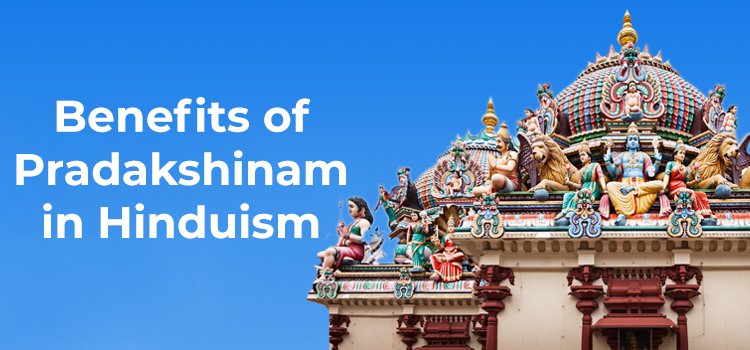Benefits of Pradakshinam in Hinduism
The Sanskrit word ‘Pradakshinam’ means 'circumambulation', or walking around in a ‘circle.’ This is a part of worship in Hindu ceremonies. The devotee walks around the garbha griha, which is the innermost chamber of the shrine that houses the temple deity. Hindus also do it around a sacred fire (Agni), the Tulsi plant, and the Peepal tree. It is also called Parikrama.
Literally, Pradakshinam means ‘to the right’ (‘dakshina’ denotes ‘right’). So when doing Pradakshinam, we go to the left side to keep the deity on our right side. Usually, people do Pradakshina after completing the traditional worship (pooja) and after paying their respects to the deity. Devotees must do Pradakshinam in a meditative mood.
The Rig Vedic verses say that the adjective ‘Pra’ means ‘very much’. It is also a prefix to verbs and means ‘onward’ or ‘forward’. Onward to Dakshinam (south) is Pradakshinam. So, one’s right side faces the deity inside the garbha griha. The circumambulation is, therefore, Dakshinacharam or auspicious.
 As per the Skanda Purana, ‘Pra’ dispels sin, ‘Da’ bestows what is desired, ‘Ksi’ destroys Karma, and ‘Na’ bestows salvation.
Hindus go around the temple’s sanctum sanctorum and also the deities at home (when doing Poojas or yajnas) in a clockwise direction. God is the center of our existence. He is omnipresent. So when we do Pradakshinam, we acknowledge that our actions and thoughts are centered around God.
The center point is fixed and stays the same, irrespective of the distance at which we do the Pradakshina. This reminds us of the eternal truth that God is the main focus of human existence and the center of gravity. This is the principle behind Pradakshinam.
Every point on the circumference of a circle is the same distance from the center. So, wherever we are, or whoever we may be, we are all equally close to God. He dispenses his grace without any bias or favor.
Adi Sankaracharya has said that real Pradakshinam is the meditation that thousands of universes are revolving around God, who is the unmoving center of all forms.
In the solar system, the sun is at the center, and the planets revolve around it. Similarly, in Pradakshinam, God is at the center. We must do the Pradakshinam slowly and never in a hurry, and our thoughts and actions must be focused on God. Pradakshinam is always in the clockwise direction, as we assume that God is on our right side. It reminds us to lead a righteous life.
Skanda Purana says that the sins committed by the mind are destroyed by the first step (of Pradakshinam), the sins committed in speech by the second step, and the sins performed by the body by the third step. So, the number of Pradakshinams is - one for Ganesha, two for Surya (Sun), three for Shiva, four for Devi and Vishnu, and seven for Peepal (sacred fig).
As per the Skanda Purana, ‘Pra’ dispels sin, ‘Da’ bestows what is desired, ‘Ksi’ destroys Karma, and ‘Na’ bestows salvation.
Hindus go around the temple’s sanctum sanctorum and also the deities at home (when doing Poojas or yajnas) in a clockwise direction. God is the center of our existence. He is omnipresent. So when we do Pradakshinam, we acknowledge that our actions and thoughts are centered around God.
The center point is fixed and stays the same, irrespective of the distance at which we do the Pradakshina. This reminds us of the eternal truth that God is the main focus of human existence and the center of gravity. This is the principle behind Pradakshinam.
Every point on the circumference of a circle is the same distance from the center. So, wherever we are, or whoever we may be, we are all equally close to God. He dispenses his grace without any bias or favor.
Adi Sankaracharya has said that real Pradakshinam is the meditation that thousands of universes are revolving around God, who is the unmoving center of all forms.
In the solar system, the sun is at the center, and the planets revolve around it. Similarly, in Pradakshinam, God is at the center. We must do the Pradakshinam slowly and never in a hurry, and our thoughts and actions must be focused on God. Pradakshinam is always in the clockwise direction, as we assume that God is on our right side. It reminds us to lead a righteous life.
Skanda Purana says that the sins committed by the mind are destroyed by the first step (of Pradakshinam), the sins committed in speech by the second step, and the sins performed by the body by the third step. So, the number of Pradakshinams is - one for Ganesha, two for Surya (Sun), three for Shiva, four for Devi and Vishnu, and seven for Peepal (sacred fig).
 As per the Skanda Purana, ‘Pra’ dispels sin, ‘Da’ bestows what is desired, ‘Ksi’ destroys Karma, and ‘Na’ bestows salvation.
Hindus go around the temple’s sanctum sanctorum and also the deities at home (when doing Poojas or yajnas) in a clockwise direction. God is the center of our existence. He is omnipresent. So when we do Pradakshinam, we acknowledge that our actions and thoughts are centered around God.
The center point is fixed and stays the same, irrespective of the distance at which we do the Pradakshina. This reminds us of the eternal truth that God is the main focus of human existence and the center of gravity. This is the principle behind Pradakshinam.
Every point on the circumference of a circle is the same distance from the center. So, wherever we are, or whoever we may be, we are all equally close to God. He dispenses his grace without any bias or favor.
Adi Sankaracharya has said that real Pradakshinam is the meditation that thousands of universes are revolving around God, who is the unmoving center of all forms.
In the solar system, the sun is at the center, and the planets revolve around it. Similarly, in Pradakshinam, God is at the center. We must do the Pradakshinam slowly and never in a hurry, and our thoughts and actions must be focused on God. Pradakshinam is always in the clockwise direction, as we assume that God is on our right side. It reminds us to lead a righteous life.
Skanda Purana says that the sins committed by the mind are destroyed by the first step (of Pradakshinam), the sins committed in speech by the second step, and the sins performed by the body by the third step. So, the number of Pradakshinams is - one for Ganesha, two for Surya (Sun), three for Shiva, four for Devi and Vishnu, and seven for Peepal (sacred fig).
As per the Skanda Purana, ‘Pra’ dispels sin, ‘Da’ bestows what is desired, ‘Ksi’ destroys Karma, and ‘Na’ bestows salvation.
Hindus go around the temple’s sanctum sanctorum and also the deities at home (when doing Poojas or yajnas) in a clockwise direction. God is the center of our existence. He is omnipresent. So when we do Pradakshinam, we acknowledge that our actions and thoughts are centered around God.
The center point is fixed and stays the same, irrespective of the distance at which we do the Pradakshina. This reminds us of the eternal truth that God is the main focus of human existence and the center of gravity. This is the principle behind Pradakshinam.
Every point on the circumference of a circle is the same distance from the center. So, wherever we are, or whoever we may be, we are all equally close to God. He dispenses his grace without any bias or favor.
Adi Sankaracharya has said that real Pradakshinam is the meditation that thousands of universes are revolving around God, who is the unmoving center of all forms.
In the solar system, the sun is at the center, and the planets revolve around it. Similarly, in Pradakshinam, God is at the center. We must do the Pradakshinam slowly and never in a hurry, and our thoughts and actions must be focused on God. Pradakshinam is always in the clockwise direction, as we assume that God is on our right side. It reminds us to lead a righteous life.
Skanda Purana says that the sins committed by the mind are destroyed by the first step (of Pradakshinam), the sins committed in speech by the second step, and the sins performed by the body by the third step. So, the number of Pradakshinams is - one for Ganesha, two for Surya (Sun), three for Shiva, four for Devi and Vishnu, and seven for Peepal (sacred fig).







